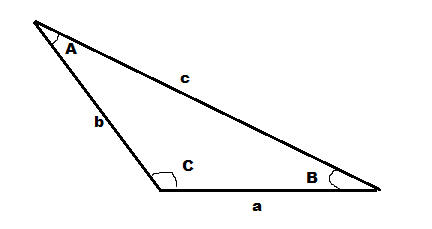
If the sides of the triangle are 6cm , 10 cm and 14 cm , then the triangle is
a.Obtuse angled triangle
b.Acute angled triangle
c.Right angled triangle
d.Equilateral triangle
Answer
573.6k+ views
Hint: We are given three sides and asked to find the type of triangle we can use the cosine law \[\operatorname{Cos} A = \dfrac{{{b^2} + {c^2} - {a^2}}}{{2bc}}\] to find the angles.
Complete step-by-step answer:
To find the type of the triangle lets find the angles of the triangle.
It's clear that it's not an equilateral triangle as the sides are not equal.
Let AB = a = 6 cm
BC = b = 10 cm
CA = c = 14 cm

The angles can be found by using the cosine formula of the triangle
$
\Rightarrow \operatorname{Cos} A = \dfrac{{{b^2} + {c^2} - {a^2}}}{{2bc}} \\
\Rightarrow \operatorname{Cos} A = \dfrac{{{{10}^2} + {{14}^2} - {6^2}}}{{2*10*14}} \\
\Rightarrow CosA = \dfrac{{100 + 196 - 36}}{{280}} = \dfrac{{260}}{{280}} = \dfrac{{13}}{{14}} \\
$
now let's find the next angle
$
\Rightarrow \operatorname{Cos} B = \dfrac{{{a^2} + {c^2} - {b^2}}}{{2ac}} \\
\Rightarrow \operatorname{Cos} B = \dfrac{{{6^2} + {{14}^2} - {{10}^2}}}{{2*6*14}} \\
\Rightarrow \operatorname{Cos} B = \dfrac{{36 + 196 - 100}}{{168}} = \dfrac{{132}}{{168}} = \dfrac{{33}}{{42}} \\
$
$
\Rightarrow \operatorname{Cos} C = \dfrac{{{a^2} + {b^2} - {c^2}}}{{2ab}} \\
\Rightarrow \operatorname{Cos} C = \dfrac{{{6^2} + {{10}^2} - {{14}^2}}}{{2*6*10}} \\
\Rightarrow \operatorname{Cos} C = \dfrac{{36 + 100 - 196}}{{120}} = \dfrac{{ - 60}}{{120}} = \dfrac{{ - 1}}{2} \\
$
From this we get that
$ \Rightarrow \operatorname{C} = {\cos ^{ - 1}}\left( {\dfrac{{ - 1}}{2}} \right) = {120^ \circ }$
From this we get that the angle C is an obtuse angle
Therefore the triangle is an obtuse angled triangle
The correct option is a.
Note: Using the sine and cosine rules to find a side or angle in a triangle. The sine rule can be used to find an angle from 3 sides and an angle, or a side from 3 angles and a side. The cosine rule can find a side from 2 sides and the included angle, or an angle from 3 sides.
You can usually use the cosine rule when you are given two sides and the included angle (SAS) or when you are given three sides and want to work out an angle (SSS). In order to use the sine rule, you need to know either two angles and a side (ASA) or two sides and a non-included angle
Complete step-by-step answer:
To find the type of the triangle lets find the angles of the triangle.
It's clear that it's not an equilateral triangle as the sides are not equal.
Let AB = a = 6 cm
BC = b = 10 cm
CA = c = 14 cm

The angles can be found by using the cosine formula of the triangle
$
\Rightarrow \operatorname{Cos} A = \dfrac{{{b^2} + {c^2} - {a^2}}}{{2bc}} \\
\Rightarrow \operatorname{Cos} A = \dfrac{{{{10}^2} + {{14}^2} - {6^2}}}{{2*10*14}} \\
\Rightarrow CosA = \dfrac{{100 + 196 - 36}}{{280}} = \dfrac{{260}}{{280}} = \dfrac{{13}}{{14}} \\
$
now let's find the next angle
$
\Rightarrow \operatorname{Cos} B = \dfrac{{{a^2} + {c^2} - {b^2}}}{{2ac}} \\
\Rightarrow \operatorname{Cos} B = \dfrac{{{6^2} + {{14}^2} - {{10}^2}}}{{2*6*14}} \\
\Rightarrow \operatorname{Cos} B = \dfrac{{36 + 196 - 100}}{{168}} = \dfrac{{132}}{{168}} = \dfrac{{33}}{{42}} \\
$
$
\Rightarrow \operatorname{Cos} C = \dfrac{{{a^2} + {b^2} - {c^2}}}{{2ab}} \\
\Rightarrow \operatorname{Cos} C = \dfrac{{{6^2} + {{10}^2} - {{14}^2}}}{{2*6*10}} \\
\Rightarrow \operatorname{Cos} C = \dfrac{{36 + 100 - 196}}{{120}} = \dfrac{{ - 60}}{{120}} = \dfrac{{ - 1}}{2} \\
$
From this we get that
$ \Rightarrow \operatorname{C} = {\cos ^{ - 1}}\left( {\dfrac{{ - 1}}{2}} \right) = {120^ \circ }$
From this we get that the angle C is an obtuse angle
Therefore the triangle is an obtuse angled triangle
The correct option is a.
Note: Using the sine and cosine rules to find a side or angle in a triangle. The sine rule can be used to find an angle from 3 sides and an angle, or a side from 3 angles and a side. The cosine rule can find a side from 2 sides and the included angle, or an angle from 3 sides.
You can usually use the cosine rule when you are given two sides and the included angle (SAS) or when you are given three sides and want to work out an angle (SSS). In order to use the sine rule, you need to know either two angles and a side (ASA) or two sides and a non-included angle
Recently Updated Pages
Why are manures considered better than fertilizers class 11 biology CBSE

Find the coordinates of the midpoint of the line segment class 11 maths CBSE

Distinguish between static friction limiting friction class 11 physics CBSE

The Chairman of the constituent Assembly was A Jawaharlal class 11 social science CBSE

The first National Commission on Labour NCL submitted class 11 social science CBSE

Number of all subshell of n + l 7 is A 4 B 5 C 6 D class 11 chemistry CBSE

Trending doubts
What is meant by exothermic and endothermic reactions class 11 chemistry CBSE

10 examples of friction in our daily life

One Metric ton is equal to kg A 10000 B 1000 C 100 class 11 physics CBSE

1 Quintal is equal to a 110 kg b 10 kg c 100kg d 1000 class 11 physics CBSE

Difference Between Prokaryotic Cells and Eukaryotic Cells

What are Quantum numbers Explain the quantum number class 11 chemistry CBSE




